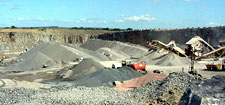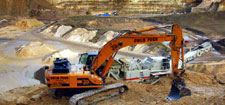Minerals
County Durham is rich in mineral resources, and mineral extraction and processing has had a considerable impact on the character of the landscape. The industry’s legacy runs deep in the landscapes of the coalfield and the North Pennines, where in addition to the more obvious physical features – old abandoned quarries and mines and restored opencast workings – the settlement, and even enclosure patterns, have evolved under the influence of the mining economy.
Mineral extraction can bring changes to the rural landscape in a number of ways.
- Natural topography may be damaged temporarily or permanently.
- Mature landscapes and landscape features like hedgerows and hedgerow trees may be lost.
- The rural character of the landscape may be eroded by the presence of industrial features – extraction faces, stockpiles and screening mounds, buildings and processing plant.
- The tranquillity of the surrounding countryside may be weakened by noise and light pollution and by increased levels of lorry traffic on local roads.
- Local distinctiveness may be weakened by insensitive restoration.
- Derelict or contaminated land may be reclaimed efficiently by recovering minerals.
- New landscape features can be created on restoration which contribute to the local landscape – ponds and wetlands, native woodlands, species rich grasslands, heathland, hedges and walls.
There will be a continued need for new mineral workings or extensions to existing workings in the future. It is important that these do not adversely affect valued attributes of the landscape, and where possible contribute to wider goals like restoring biodiversity.
Issues and Objectives
Planning for New Development
The adopted County Durham Minerals Local Plan 2000 sets out the detailed local planning policies and proposals that guide mineral working. It will be replaced by the emerging County Durham Minerals and Waste Local Development Framework. This will contain policies concerning the general needs for new mineral working, the efficient use of resources, and the protection of the environment and amenity of those affected by it. It will also contain specific proposals for future working of particular minerals. The County Durham Landscape Assessment and Strategy will contribute to this process, informing landscape policies and the identification of allocated sites or areas of search.
Objectives
- To inform Local Development Framework policies and allocations.
Guiding New Development
Mineral working inevitably involves change in the landscape. The extent to which this is positive or negative depends on how sites are selected, designed, and restored. The County Durham Landscape Character Assessment and Strategy provides baseline information on landscape character and broad objectives for county character areas which can be used to inform these processes. Building-in Sustainability, the regional guide to sustainable building and development, provides guidance on how to adopt sustainability principles in mineral workings. A Supplementary Planning Document is currently being prepared as part of the Minerals and Waste LDF which will give further guidance on landscape issues.
Objectives
- To inform and support the development of a Supplementary Planning Document on Minerals and Waste.
Existing Mineral Sites
Mineral workings can be long lived and many existing sites date from planning permissions granted some time ago when standards were lower. The operation and restoration of sites granted permission between 1948 and 1982 is now subject of a review process under the Environment Act 1995. Despite this process there are often residual impacts – particularly visual impacts – that are difficult to mitigate. In some areas – and particularly on the limestone escarpment – the cumulative impact of existing sites is significant and likely to increase in the coming decades. Action plans for areas such as these which provided for off site structure planting and hedgerow planting, together with improvements to disrupted footpath networks, could address some of these issues.
Objectives
- To encourage improvements to the appearance of active and dormant mineral workings.
- To promote and support area based initiatives that address the impacts of mineral workings.
Creative Restoration
The restoration of mineral workings can offer significant opportunities to meet wider goals like enhancing landscape character and biodiversity, increasing access to the countryside, or contributing to the expansion of woodland. This Strategy identifies broad objectives for local landscapes which should be used, together with the Landscape Guidelines and other strategies like the Durham Biodiversity Action Plan, to inform the after-use and detailed design of restored sites.
Objectives
- To encourage the creative restoration of mineral workings to restore or enhance landscape character and biodiversity and bring benefits to local communities.
Legacies from the Past
Mineral working has had an enduring impact on much of the Durham landscape. Some features like old quarries and lead mining remains are important components of local landscape character. Other mining legacies – dereliction, the contamination of watercourses and beaches, the poor restoration design of early opencast workings and reclamation schemes – are problematic. Some derelict sites have a nature conservation or heritage value which needs to be balanced against their environmental problems. The reclamation programme, together with initiatives like the Turning The Tide project on the coast, has accomplished a great deal in recent decades. Further work is required to deal with residual issues like contamination and pollution, and to improve the character and conservation value of restored land.
Objectives
- To promote an understanding of the importance of mining heritage to the character of local landscapes and to secure the conservation of key features.
- To promote and support landscape renewal initiatives which seek to improve the character and biodiversity of areas affected in the past by mineral working.



